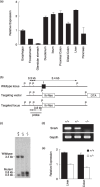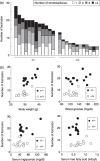Susceptibility of Snark-deficient mice to azoxymethane-induced colorectal tumorigenesis and the formation of aberrant crypt foci
- PMID: 18307533
- PMCID: PMC11158890
- DOI: 10.1111/j.1349-7006.2008.00734.x
Susceptibility of Snark-deficient mice to azoxymethane-induced colorectal tumorigenesis and the formation of aberrant crypt foci
Abstract
SNF-1/5'-AMP-activated kinase (AMPK)-related kinase (SNARK) is a member of the AMPK-related kinases. Snark(+/-) mice exhibited mature-onset obesity and related metabolic disorders. Obesity is regarded as a risk factor for colorectal cancer. To investigate whether Snark deficiency is involved in tumorigenesis in the large intestine, obese Snark(+/-) mice were treated with a chemical carcinogen, azoxymethane (AOM). The incidences of both adenomas and aberrant crypt foci (ACF) were significantly higher in Snark(+/-) mice than in their wild-type counterparts 28 weeks after the completion of AOM treatment (10 mg/kg/week for 8 weeks). Furthermore, ACF formation was enhanced in Snark(+/-) mice treated with AOM for 2 weeks, suggesting that Snark deficiency contributed to the early phase of tumorigenesis. The total number of ACF was correlated with bodyweight in Snark(+/-) and Snark(+/+) mice, suggesting that obesity was a risk factor for colorectal tumorigenesis in this model. However, the correlation coefficient was higher in Snark(+/-) mice. Moreover, AOM-induced ACF formation was also enhanced in preobese Snark(+/-) mice. Together, these findings suggest that AOM-induced tumorigenesis in Snark(+/-) mice was enhanced via obesity-dependent and -independent mechanisms.
Figures



Similar articles
-
Qualitative and quantitative relationship between dysplastic aberrant crypt foci and tumorigenesis in the Min/+ mouse colon.Cancer Res. 2001 Jul 1;61(13):5010-5. Cancer Res. 2001. PMID: 11431334
-
Sequential and morphological analyses of aberrant crypt foci formation in mice of differing susceptibility to azoxymethane-induced colon carcinogenesis.Carcinogenesis. 2000 Aug;21(8):1567-72. Carcinogenesis. 2000. PMID: 10910960
-
Identification of flat dysplastic aberrant crypt foci in the colon of azoxymethane-treated A/J mice.Int J Cancer. 2006 Feb 1;118(3):540-6. doi: 10.1002/ijc.21416. Int J Cancer. 2006. PMID: 16094649
-
Age-dependent susceptibility to azoxymethane-induced and spontaneous tumorigenesis in the Min/+ mouse.Anticancer Res. 2003 Jan-Feb;23(1A):259-65. Anticancer Res. 2003. PMID: 12680222
-
Effect of dietary galacto-oligosaccharides on azoxymethane-induced aberrant crypt foci and colorectal cancer in Fischer 344 rats.Carcinogenesis. 2001 Jan;22(1):127-32. doi: 10.1093/carcin/22.1.127. Carcinogenesis. 2001. PMID: 11159750
Cited by
-
NUAK2: an emerging acral melanoma oncogene.Oncotarget. 2011 Sep;2(9):695-704. doi: 10.18632/oncotarget.325. Oncotarget. 2011. PMID: 21911917 Free PMC article. Review.
-
Targeted therapies of the LKB1/AMPK pathway for the treatment of insulin resistance.Future Med Chem. 2010 Dec;2(12):1785-96. doi: 10.4155/fmc.10.264. Future Med Chem. 2010. PMID: 21428801 Free PMC article. Review.
-
Sucrose nonfermenting AMPK-related kinase (SNARK) mediates contraction-stimulated glucose transport in mouse skeletal muscle.Proc Natl Acad Sci U S A. 2010 Aug 31;107(35):15541-6. doi: 10.1073/pnas.1008131107. Epub 2010 Aug 16. Proc Natl Acad Sci U S A. 2010. PMID: 20713714 Free PMC article.
-
The AMPK-related kinase SNARK regulates muscle mass and myocyte survival.J Clin Invest. 2016 Feb;126(2):560-70. doi: 10.1172/JCI79197. J Clin Invest. 2016. PMID: 26690705 Free PMC article.
-
Drosophila NUAK functions with Starvin/BAG3 in autophagic protein turnover.PLoS Genet. 2020 Apr 22;16(4):e1008700. doi: 10.1371/journal.pgen.1008700. eCollection 2020 Apr. PLoS Genet. 2020. PMID: 32320396 Free PMC article.
References
-
- Kahn BB, Alquier T, Carling D, Hardie DG. AMP‐activated protein kinase: ancient energy gauge provides clues to modern understanding of metabolism. Cell Metab 2005; 1: 15–25. - PubMed
-
- Manning G, Whyte DB, Martinez R, Hunter T, Sudarsanam S. The protein kinase complement of the human genome. Science 2002; 298: 1912–34. - PubMed
Publication types
MeSH terms
Substances
LinkOut - more resources
Full Text Sources
Medical
Molecular Biology Databases

